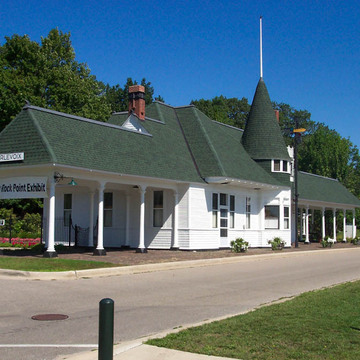You are here
Charlevoix Historical Society Depot Museum (Charlevoix Depot of the Chicago and West Michigan Railroad)
Built in 1892 on the rail route between Traverse City and Petoskey and Bay View, the small wooden station served resorters bound for the Chicago and Belvedere clubs. On reaching Charlevoix the railroad skirted Lake Charlevoix (formerly Pine Lake) for a mile, stopping first at a little station close to the Belvedere Hotel of the Belvedere Association, formerly the Kalamazoo Resort. This depot burned in 1931. Then the railroad crossed the narrow channel between Round Lake and Lake Charlevoix, stopping at the Charlevoix Depot. From the depot, stairs rose up the hillside to the large elegant Charlevoix Inn of 1898 (demolished), which was built by the Chicago and West Michigan Railroad Company. Depot Park stretches to the water's edge.
The depot's large hipped roof and covered platforms sheltered arriving and departing passengers and their baggage. From the ticket window in the projecting conical-roofed tower, the ticket agent could see the track and approaching trains. Passenger service ended in 1962. When the Chesapeake and Ohio abandoned its rail lines north of Manistee in 1982, freight traffic ended. In 1992 Robert and Mary Pew, then owners of the station, donated the building to the Charlevoix Historical Society for history programs. In the knowledge that gardens frequently adorned the grounds of train stations, the Charlevoix Area Garden Clubs are developing a heritage garden here.
Writing Credits
If SAH Archipedia has been useful to you, please consider supporting it.
SAH Archipedia tells the story of the United States through its buildings, landscapes, and cities. This freely available resource empowers the public with authoritative knowledge that deepens their understanding and appreciation of the built environment. But the Society of Architectural Historians, which created SAH Archipedia with University of Virginia Press, needs your support to maintain the high-caliber research, writing, photography, cartography, editing, design, and programming that make SAH Archipedia a trusted online resource available to all who value the history of place, heritage tourism, and learning.


